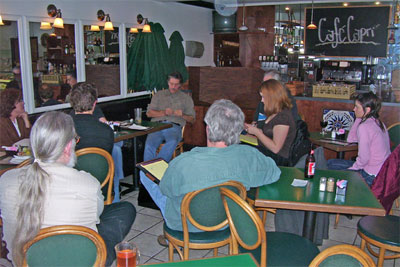This past Thursday, 15 people gathered at Nabeel’s in Homewood to discuss what options exist to bring a community radio station to the Birmingham, Alabama market. Those in attendance realized that this action will be harder than it sounds.
Philip Jordan’s story in a recent Birmingham Weekly hits the nail on the head with regards to local concerns about the recent changes to the terrestrial radio landscape. We’ve had people from all over the place share their thoughts about what they like, don’t like, who they blame and whether hell, fire and brimstone are going to strike the city. You can find most of the comments here, though there are some here and here.
During their 1+ hour discussion, many of the common concerns shared by those following the demise of terrestrial radio as we knew it were brought up. These include the fact that it’s become a market dominated by conglommerates, reducing the need or ability to take risks with programming. Many people also argue that the current segmentation of the radio dial has led to extreme narrowing of target audiences, sometimes preventing exposure to new types of music. Many pointed to the need to secure a low frequency FM signal to start and then use the success of that signal to encourage corporate stations to make the switch from piped in format to one focusing on the local scene. Potential solutions for the issue include creating additional internet radio stations or convincing WBHM to diversify its current offerings. Those in attendance were more inclined to support the latter as they see it as the local public station that should be serving the public’s requests. They are willing to create CDs providing people with a taste of what local independent radio stations would sound like, lists showing what stations already exist; anything to help with thier goal of having a diverse broadcasting home serving the needs of the metro community.
One issue I brought up in the conversation was the need for those “minorities” to have additional choices. Many corporate stations apparently believe that those communities are served very well. This is despite the fact that most Latinos living in the area are regulated to 2 hours of Spanish broacasting on AM per week; we haven’t even really looked at the services provided to Caribbean expatriates or to those that long to hear the blues, traditional jazz, or a clearer signal on local issues that affect all people.
People will definitely want to see a station like Fried Green Radio (http://friedgreenradio.com), having recently started transmission this month succeed. The arhument in res The ultimate goal of an AM signal would do more for the concerns than the humble beginnings in the station’s plans. It would be foolish to not at least admit that one of the problems facing the digital stations is the availability of computers to those that could enjoy radio free of the trappings of the car or home audio system, namely commercial overkill.
There are many that only enjoy computer access at school or at home, despite the falling costs of desktops and laptops. It may be less expensive for those that have the financial means to do so. For those of us living paycheck to paycheck or worse, the ability to find and support new voices and avenues become complicated. You can name the reason: education, wages, mass transit… we could go on and on. Those who have the tools to assist in changing the area’s landscape should take advantage of every opportunity to do so.
Despite my current love affair with my old standby, mvyradio.com, I’m also always willing to give Fried Green Radio and any of the other numerous internet stations a try. One idea that was not brought up during the meeting, but in other conversations I’ve had about the topic is to boycott those stations that do not provide a service to you. The one thing that probably protects terrestrial radio from a complete boycott in this area is the reliance that the residents have on it as a source of information about local emergencies. You can’t necessarily listen to the weather report online if there’s no power to run the computer during a storm. Those stations that made changes to their format to address the needs of all of their listeners would receive more support. This would be a veriation of the idea to encourage public radio station members to earmark their contributions for new programming when they renew rather than support that which they do not listen to.
We can always hope that the community presents a viable alternative, whether it means encouraging the continued expansion of music venues in the city such as The Bottletree, The Nick, Cave 9 or Marty’s. We could also hope that those supporters of this project are successful in their efforts. Time will tell.
For Those interested in becoming invovled in this project are encouraged to contact Ken Harrelson @ kharrelson505[at]charter[dot]net. Later on today we’ll post a list handed out at the meeting to provide examples of independent radio stations.
Cheers.

